MARKET OVERVIEW
The Global T Cell Therapy market is an emerging sector under the health care stream of work, focusing on advanced therapies that harness the power of T cells to treat diseases. T cell therapy is such a revolutionary approach that utilizes the body's immune system against illness-like cancer and autoimmune disorders. This innovative field is beginning to mold treatment paradigms by offering personalized therapies based on individual patients' immune profiles.
The Global T Cell Therapy market in recent years has taken tremendous strides, primarily driven by pioneering research and technological breakthroughs. These therapies modify a patient's own T cells to recognize and destroy cancer cells or suppress autoimmune responses. These are targeted therapies with fewer side effects than traditional therapies.
The growth trajectory for T cell therapies is very strong as indicated by market dynamics, largely driven by research and development investments that are increasing in the past few years. Companies are increasingly looking into new applications and significantly scaling up clinical trials to validate efficacy and safety of treatments in different patient populations. As regulatory approvals go around the world, accelerated adoption is seen in mainstream clinical practice.
Technological innovations in genetic engineering and biotechnology serve as the future direction of shaping what is to be the new face of T cell therapies. Developments are continued concerning the use of gene-editing techniques, such as CRISPR/Cas9, which are aimed at increasing the precision and scaling up the manufacturing process of T cells. These are then expected to lead to bringing down the cost of making T cells more accessible. Such a trend will pave the way for possible intensive use in the clinic.
Global T Cell Therapy has emerged to a new level through partnerships between biopharmaceutical firms, academic institutions, and healthcare providers. It may lead to an exchange of knowledge, accelerate clinical development, and bring about innovation in therapies. Market stakeholders are actively looking for ways to overcome logistical challenges associated with manufacturing, distribution, and making the therapy accessible to all patients around the world for smooth integration into healthcare systems around the globe.
The Global T Cell Therapy market will continue to grow as novel therapeutic targets are discovered and clinical results become maximized. Future products may also include combination therapies that provide synergistic enhancement of T cell efficacy, but they might also be developed to extend beyond oncology into infectious diseases and chronic inflammatory conditions.
Global T Cell Therapy Market is a revolutionary force in healthcare. These truly personalized therapies tap into the tremendous power of an individual's own immune system to aggressively target disease sites for potentially long-lasting benefits. With research currently underway that strives to improve and enhance the extendibility of such therapeutic possibilities, one can expect T cell therapies to drive a new set of global standards of care.
Global T Cell Therapy market is estimated to reach $27619.2 Million by 2031; growing at a CAGR of 29.0% from 2024 to 2031.
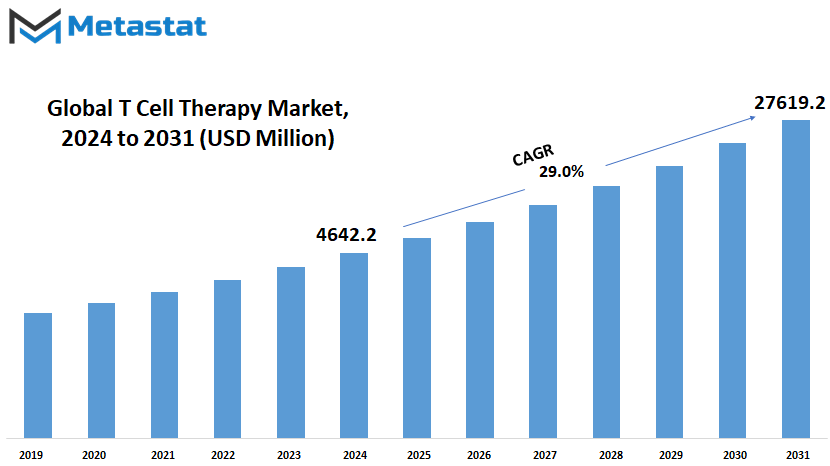
GROWTH FACTORS
A number of factors have put the Global T Cell Therapy market on the way to significant growth in the coming years. First and foremost among these is the rise in the worldwide prevalence of cancer. As the incidence of this disease continues to grow in every region, including developing ones, there is an increased need for effective treatment options such as T Cell Therapy. Since this therapy can more precisely target and eliminate the affected cells than traditional treatments, more and more patients are opting for it.
Substantial investments in research and development are quite important for further growth in the market. Pharmaceutical companies along with research institutions are heavily investing in bettering T Cell Therapy techniques and discovering more applications of the therapy. Such investments will eventually be reflected in more efficient and less side-effecting therapies that will fuel further market growth.
However, T Cell Therapy high costs as well as not being extended, reimbursement policies could be a barrier for the market growth. High costs related to developing and implementing these therapies create monetary barriers both for patients and for healthcare providers. In addition, the differences in reimbursement policies may cross borders and create boundaries between the regions and countries, which would widen access mainly to poorer areas.
The CAR-T cell therapy is one of the most promising areas of future growth in the market. CAR-T therapies mean the genetic modification of a patient's T cells so they can recognize and attack cancer cells much better. Trials are going on for perfecting these therapies, which will be more effective across forms of cancers and have a better safety profile on the whole. Once these advances are fully realized, it will most likely open up further opportunities for the T Cell Therapy market, and it should spur further investment while increasing access to treatment for the entire globe.
Even though challenges like high costs and reimbursement issues still await the area, it enjoys the advantage of a growing cancer prevalence, accompanied by large R&D investments. All these would soon bring new growth pathways, thereby marking T Cell Therapy as a harbinger for what the future would look like for the treatment of cancer.
MARKET SEGMENTATION
By Therapy Type
Developments are in the offing that may lead to a very promising future for the global T Cell Therapy market, opening the door to novel treatment strategies that could be game-changers in healthcare. T Cell Therapy is a promising method that uses the might of the human immune system to chas and destroy cancerous cells, huge potentials in personalized medicine.
CAR T-cell Therapy also constitutes an important segment for this market. This therapy is a process in which patient's T cells are genetically engineered to express CARs. T cells identify the proteins specifically presented on the surface malignancy, thereby launching precision attacks against cancer cells. The immediate dramatic effectiveness of CAR T-cell Therapy in treating specific types of leukemia and lymphoma was documented with the observation of durable remissions in patients who were out of other clinical options.
Another promising area is T Cell Receptor (TCR)-based Therapy, where T cells are engineered to express TCRs capable of recognizing cancer-specific antigens presented on the tumor cells' surface. This approach opens up much larger areas of cancers that might be targeted, thus offering a more adaptive and customized therapeutic strategy.
Hope lies in TIL-based Therapy that allows for the utilisation of natural T cells extracted from a patient's tumor tissue for its expansion and reinfusion leading to an enhanced anti-tumor activity. Because it specifically helps in the natural infiltration of T cells into tumors and mounts an immune response against cancer cells, this therapy may lie in future treatments for solid tumors.
Future looking ahead, the evolution of T Cell Therapy will continue to proceed on a trajectory that will further advance with advancements in technology as well as continued research in this area. It will see further developments in generic engineering techniques, biomarker identification, and manufacturing processes that significantly improve efficacy and apply in all the different types of cancers. Academic institutions, biotechnology companies, and healthcare providers will have to come together to streamline clinical developments in order to offer such treatments to the patients undergoing such revolutionizing treatments.
Innovations in CAR T-cell Therapy, TCR-based Therapy, and TIL-based Therapy propel the growth of the global T Cell Therapy market. These innovations might usher in a new era of treatment for cancer in patients as well as health practitioners around the world. As the research continues to shape the progress, T Cell Therapy is seen as one of the cornerstones in the future of oncology care as marking a new era of precise and effective cancer therapies.
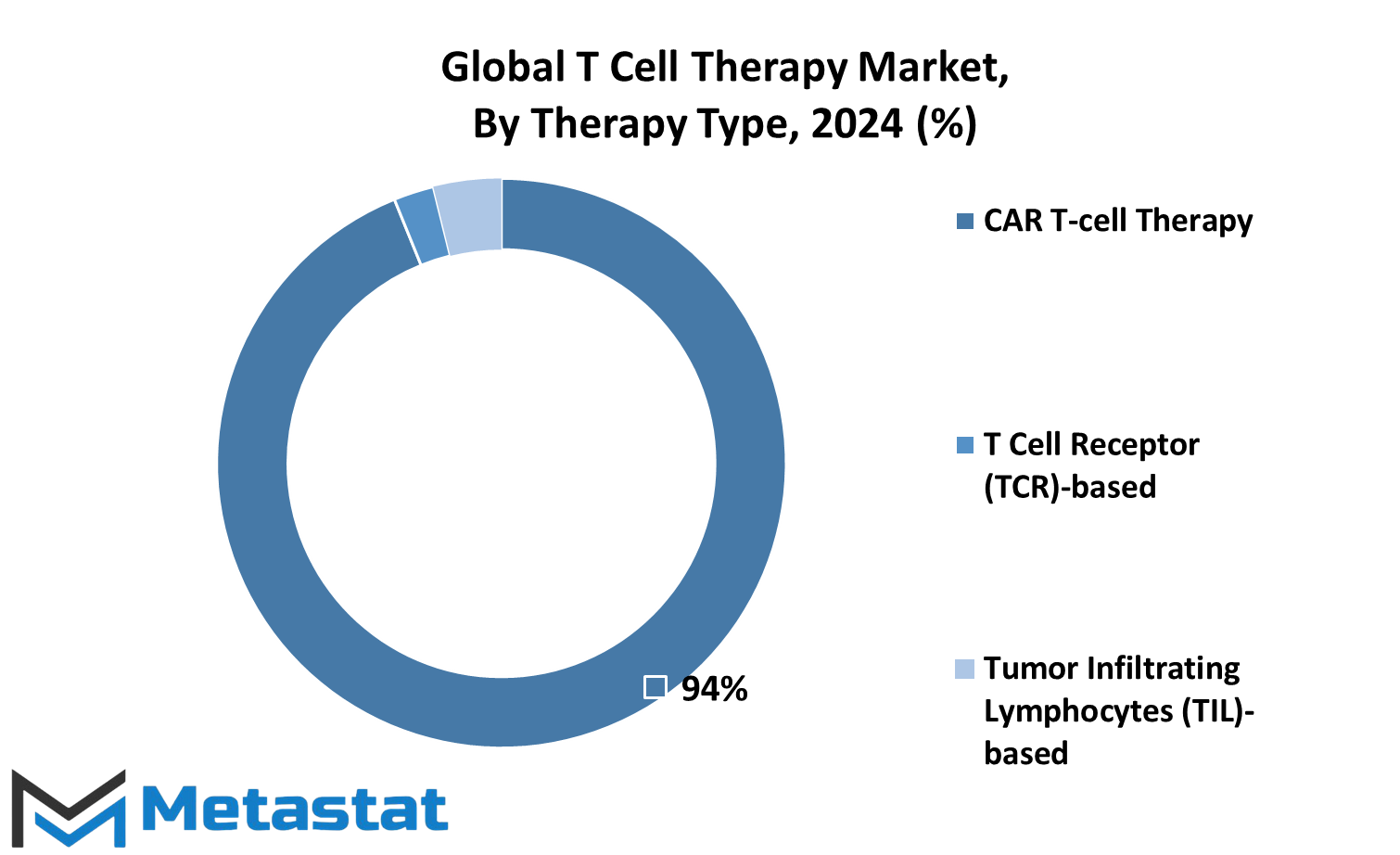
By Indication
The future outlook of the global T Cell Therapy market is going to change and expand dramatically. T Cell Therapy offers notable hope for the treatment of various medical conditions mainly targeting hematologic malignancies and certain solid tumors and other medical conditions.
Hematologic malignancies will still be one of the major sources of demand in this market. The novel approach adopted by T Cell Therapy in targeting and removing tumor cells from the blood and bone marrow is just the start of an entirely new revolution in cancer treatment. Novel technologies, such as therapies targeted at specific hematologic cancers, will emerge in the future as research continues its route.
Expansion of market in solid tumors is also being projected by a paradigm shift in the strategies for the treatment of cancer. The majority share in the scene presented by solid tumors takes place within organs like lungs, breasts, and prostate. These are diverse and are endowed with mechanisms of resistance, thus posing a challenge to scientists. Precise targeting of tumor cells while protecting healthy tissue presents promising potential of T Cell Therapy. Active research could be an approach towards developing the concepts of T Cell Therapy for solid tumors so that they are more applicable and efficacious in various kinds of cancers. Beyond hematologic malignancies and solid tumors, the market encompasses many other indications. Patients with autoimmune diseases or viral infections are among those to whom T Cell Therapy will be vital in affecting their immune response. Future developments might also include much broader applications of T Cell Therapy for the immunopathologies of patients with autoimmune diseases such as rheumatoid arthritis and multiple sclerosis will be a key perspective that can be very beneficial for millions who live with chronic immune disorders.
By Hematologic Malignancies Type
T Cell Therapy stands poised as an impetus within the Global T Cell Therapy market amidst the blossoming vistas of rising medical interventions. It has found use to treat a variety of cancers by wielding its body's own immune system against them and, particularly, Hematologic Malignancies like Lymphoma, Leukemia, and Myeloma. This is an utterly new concept of oncology treatment as the initial attempts at mainstream and palliative treatment with conventional drugs have been flaking failures.
The two major diseases of the treatment protocols of T Cell Therapy are Lymphoma, which manifests its presence in lymphocyte hyperplasia, and Leukemia, which involves the blood system and the bone marrow. This therapy has tremendous potential to even change the course of treatment for these malignancies in the body by boosting natural defenses against such diseases. Another frontier is that of Myeloma, the cancer of plasma cells: because of its precise targeting mechanisms, T Cell Therapy will be able to tackle it in a much more effective way than so far achieved.
The future potential growth of the Global T Cell Therapy market appears to be very substantial, backed by enhanced R and D activities, increased clinical trials, and growing investment by the pharmaceutical companies. Increasing T Cell Therapy applications across various forms of cancers like Hematologic Malignancies, with refining and expanding applicability, will lead to increased adoption worldwide.
Further, T Cell Therapy in the future will be more personalized with treatments targeted towards a specific genetic makeup, which will provide the utmost enhancement of both efficacy and reduction of adverse effects. These goals of personalization along with the advancement of biotechnology and genetic engineering will enable the leap of the market for T Cell Therapy in the near future.
The key players in this value chain are healthcare providers, researchers, and the patients themselves, who will soon be able to benefit from such advances as T Cell Therapy sets the benchmark for integrative therapies into regular oncological practice. With treatment protocols and technological innovation continuing to evolve, it is apparent that growth in the market is very much assured, and T Cell Therapy stands at the forefront of cancer research and clinical practice.
By Leukemia Type
T Cell Therapy leads the front for advanced treatments in the world healthcare of the future. It engages with the innate immune system of an individual to fight all forms of cancers. Going forward, the Global T Cell Therapy market will be major and diversifying, especially when segmented by leukemia types such as Melanoma, Brain & Central Nervous System, Liver Cancer, and others.
T Cell Therapy marks the front of the new wave in cancer therapy treatment. It exploits one's T cells that are genetically engineered to specifically recognize cancer cells for attack. Such treatment promises more targeted and effective outcomes compared to such treatments with chemotherapy and radiation. Customizing treatments with respect to particular forms of cancer, as the case may be, makes for greater effectiveness and diminished adverse effects-this is really an advancement in personalized medicine.
In the near future, the Melanoma segment of the Global T Cell Therapy market is also expected to expand with a high rate. Melanoma is that type of skin cancer which has been highly aggressive so far and is therefore considered an important area where T Cell Therapy can really present a message. It ensures the targeted killing of melanoma cells by preserving healthy tissue to not only prolong survival but also to improve the quality of life through fewer treatment-related side effects.
Meanwhile, hope seems to have shifted towards the Brain & Central Nervous System segment due to T Cell Therapy. With so delicate areas of the human body involved with cancer progression, it would demand peculiar methods of healing; however, T Cell Therapy can cross the blood-brain barrier, destroying tumors inside the body, soothing people who for so long had deemed their medical condition untreatable, then offering them hope.
The further, in addition to Liver Cancer, all other types in the market segmentation, signify that T Cell Therapy is applicable to various oncological settings, and the results of research and development efforts are set to push forward genetic engineering and immunotherapy techniques to improve and extend even further the therapeutic usefulness of T Cell Therapy.
.
|
Report Coverage |
Details |
|
Forecast Period |
2024-2031 |
|
Market Size in 2024 |
$4642.2 Million |
|
Market Size by 2031 |
$27619.2 Million |
|
Growth Rate from 2024 to 2031 |
29.0%% |
|
Base Year |
2022 |
|
Regions Covered |
North America, Europe, Asia-Pacific Green, South America, Middle East & Africa |
REGIONAL ANALYSIS
The major geographical markets include North America, Europe, and Asia-Pacific, wherein each plays an important role in shaping the landscape of this market and its growth prospects into the future. Among these, North America has been the leader, which includes the United States, Canada, and Mexico. It has a well-developed healthcare structure and a huge investment in biotechnology; thus, it is more likely to lead in adopting T Cell Therapy and its development. The region's robust regulatory framework and also the good financial support of both the public and private sectors are likely to spur further market growth. Europe, including the United Kingdom, Germany, France, Italy, and other European countries, is a close second. With a sophisticated health care system and an increased emphasis on personalized medicine, Europe holds enormous opportunities for developing markets in T Cell Therapy. Growing research and development initiatives along with collaboration between academic institution and pharmaceutical companies will pave the way for innovations and further market penetration.
India, China, Japan, and South Korea are the key players of the Asia-Pacific market. Rapid economic growth, improving healthcare infrastructures, and an enormous pool of patients in Asia-Pacific offer a vast potential for developing T Cell Therapy. Government support for research in biotechnology research and modernization of healthcare is likely to propel the market forward across the region.
The other significant region in the global market for T Cell Therapy is South America. Brazil, Argentina, and many other countries of this region are promising growth. Higher healthcare expenditure and surging awareness about advanced treatment options are facilitating the demand. Collaborations with international biotech companies and local research institutions will promote technological transfer and fuel growth in the South American market.
The Middle East & Africa region, which includes the GCC Countries, Egypt, South Africa, etc, is witnessing slow but steady growth in the acceptance of T Cell Therapy. The growth in healthcare infrastructure and increasing investment in biotechnology is expected further to boost the market in these regions.
Overall, the T Cell Therapy market is poised to witness sharp upturns in each of the regions. With advancing research and evolving regulatory frameworks, these geographies will spearhead the future of T Cell Therapy and open up new doors for patients and stakeholders in the next few years.
COMPETITIVE PLAYERS
In a rapidly advancing landscape of health and biotechnology, Global T Cell Therapy stands aptly positioned at the very frontier of revolutionary treatments. T Cell Therapy, indeed, will radically make use of the immune system to fight diseases such as cancer and forms a definite shift towards personalized medicine. And when it comes to what will herald this medical revolution, key players would be integral.
At the forefront is Novartis AG, who made CAR-T cell treatments. The developing avenues for new therapies have now revolutionized treatment paradigms and offered hope to patients worldwide. Novartis is not alone in this brilliant work. Along with Novartis, Ncardia (Cellistic) has also made significant strides. Its R&D focused on developing scalable cell therapy platforms that promise improved accessibility and efficacy.
One of the key players in biopharmaceuticals is Merck KGaA through its efforts in T Cell Therapy that include strategic partnerships and internal research initiatives. This essentially entails a comprehensive approach ranging from research at the fundamental stages to clinical applications that offer wholesome solutions for patients. Similarly, Bristol-Myers Squibb and Pfizer Inc. have entered alliances in order to strengthen the capabilities of these pharmaceutical companies in cellular therapies, thereby improving treatment options and ultimately producing a better end for different patient populations.
Marker Therapeutics and Bluebird Bio Inc. are among the leaders in the genetic medicine space. Their work on T Cell Therapy underlines their willingness to fight unmet medical needs, especially in hematologic malignancies and solid tumors. Adaptimmune Therapeutics plc and T-knife Therapeutics are well on their way to determining a new niche with novel TCR-engineered therapies that will promise genotypic cures.
Sorrento Therapeutics, as well as Precision Biosciences, are significantly at the forefront in cutting-edge genome editing technologies. Amgen Inc. and Autolus Therapeutics used their enormous body of biologics expertise to assist in creating new CAR-T therapies that will be safe and effective. Gilead Sciences (Kite Pharma) and CARsgen Therapeutics Limited have shown a number of programs at an expedited pace to commercialization with access to additional regulatory clearances that will further expand treatment availability.
Poseida Therapeutics and iCell Gene Therapeutics Inc. are leaders in developing platforms for gene editing that can revolutionize scalability and bring it down to a more affordable level for T Cell Therapy. Allogene Therapeutics and Atara Biotherapeutics have off-the-shelf T Cell therapies to make the logistics easier and expedite the timeline for treatments. Fate Therapeutics is leading in induced pluripotent stem cell-derived T Cell therapies and has designed treatments customized for individual patients.
As such innovative competitive players continue to do their magic and collaborate, the market of Global T Cell Therapy is bound to boom exponentially. Efforts from these individuals are driving forward scientific advancements and promising to unlock transformative patients' outcomes all to usher in a new chapter where cell therapies become one's personal prescription by modern medicine.
T Cell Therapy Market Key Segments:
By Therapy Type
- CAR T-cell Therapy
- T Cell Receptor (TCR)-based
- Tumor Infiltrating Lymphocytes (TIL)-based
By Indication
- Hematologic Malignancies
- Solid Tumors
- Others
By Hematologic Malignancies Type
- Lymphoma
- Leukemia
- Myeloma
By Leukemia Type
- Melanoma
- Brain & Central Nervous System
- Liver Cancer
- Others
Key Global T Cell Therapy Industry Players
- Novartis AG
- Ncardia (Cellistic)
- Merck KGaA
- Bristol-Myers Squibb Company
- Pfizer Inc.
- Marker Therapeutics, Inc.
- Bluebird Bio Inc.
- Adaptimmune Therapeutics plc
- T-knife Therapeutics, Inc.
- Sorrento Therapeutics, Inc.
- Precision Biosciences, Inc.
- Amgen Inc.
- Autolus Therapeutics
- Gilead Sciences, Inc. (Kite Pharma)
- CARsgen Therapeutics Limited
WHAT REPORT PROVIDES
- Full in-depth analysis of the parent Industry
- Important changes in market and its dynamics
- Segmentation details of the market
- Former, on-going, and projected market analysis in terms of volume and value
- Assessment of niche industry developments
- Market share analysis
- Key strategies of major players
- Emerging segments and regional growth potential




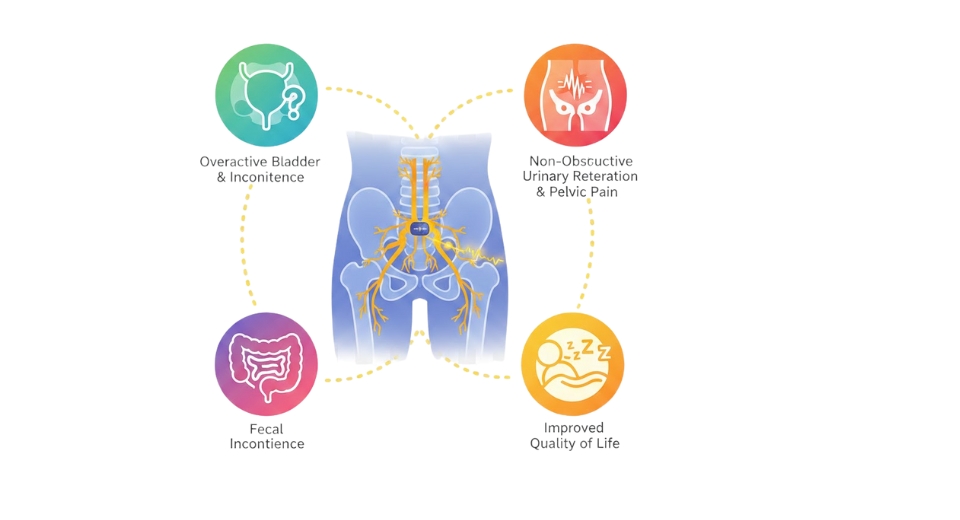
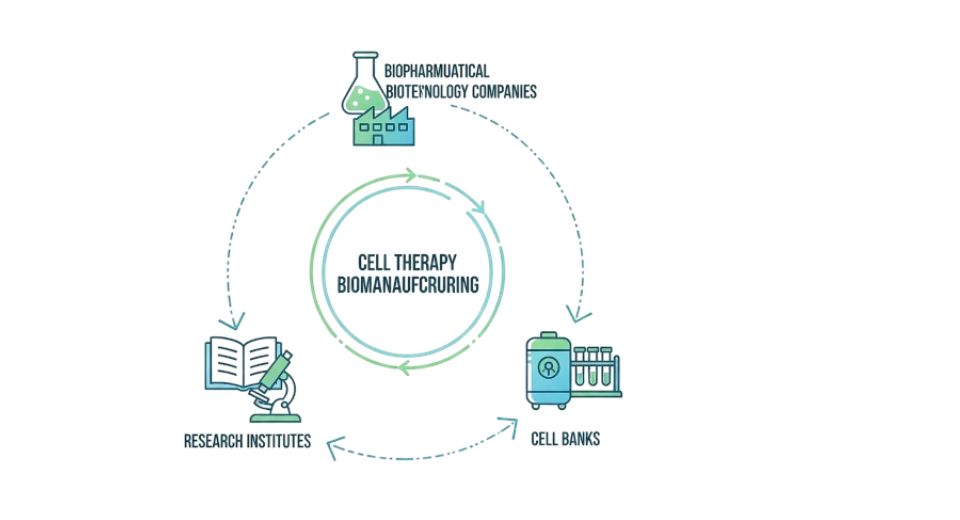
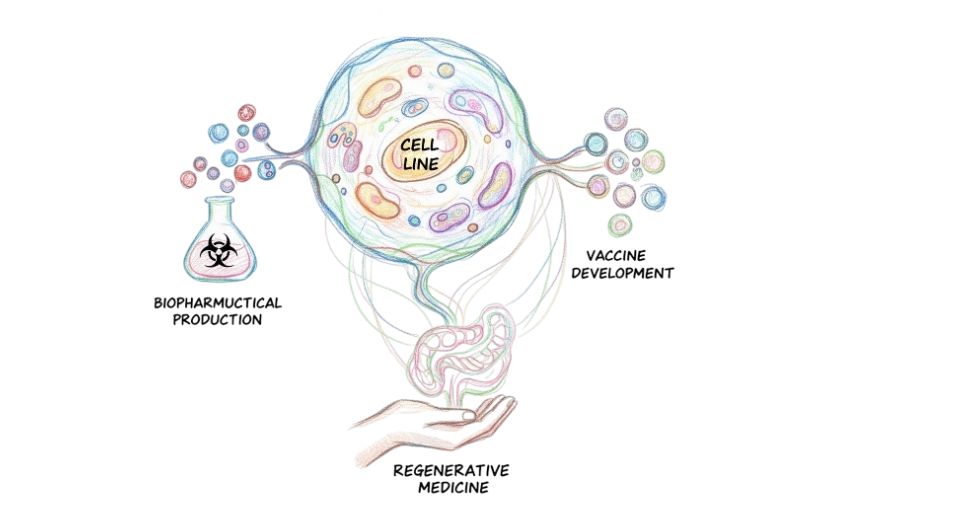

 US: +1 3023308252
US: +1 3023308252






